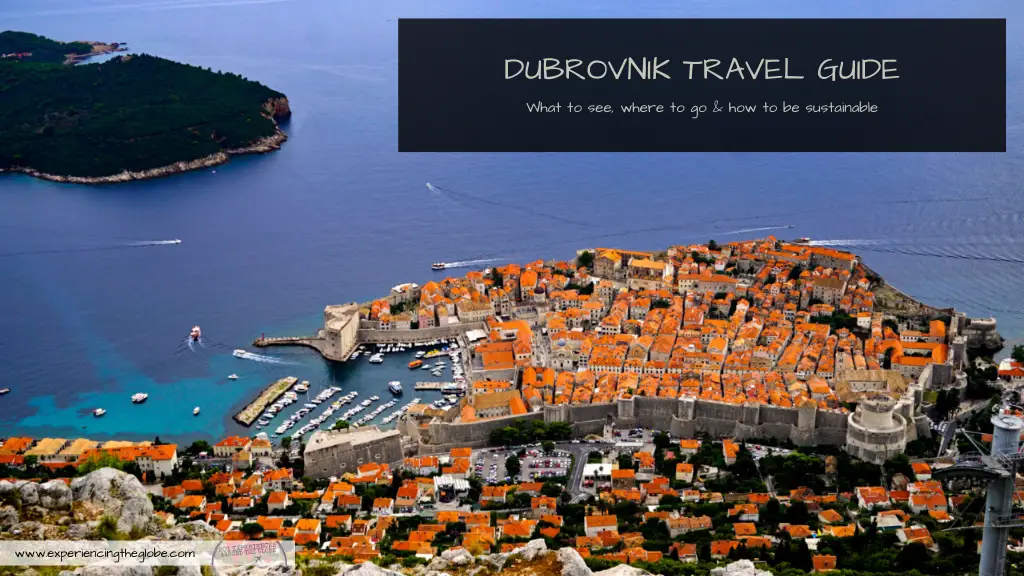
Here’s all you need to know about Dubrovnik, from understanding how the city came to be, to practical information about visiting, you’ll get an overview of the top places to visit, and tips to make your stay sustainable and help fighting overtourism in Dubrovnik. You’ll also find suggestions for day trips and where to go next. Of course, we’ll also talk about the series that made Dubrovnik a hotspot, Game of Thrones. Are you ready to get all your Dubrovnik related questions answered? Let’s go explore beyond King’s Landing!
In my humble opinion, Dubrovnik is one of the most beautiful cities in the world. The mix of grey stone, terracotta roofs and cerulean sea is intoxicating. But this has meant that the flux of visitors increases year after year, making it a posterchild of overtourism. Don’t let that discourage you –the city deserves all the attention is getting, and it’s still a great destination!
Lonely Planet described it in a lovely way, which I think might convince you, if you still have any doubts: “Dubrovnik is simply unique; its beauty is bewitching, its setting sublime. Thousands of visitors walk along its marble streets every day, gazing, gasping and happily snapping away”.
Bewitched you’ll be, no doubt! With 250 days of sun a year, Dubrovnik offers long summers to enjoy the Adriatic surrounded by tons of history, stunning architecture and a fantasy world of queens and dragons.
I’ve been lucky enough to visit Dubrovnik several times, in different seasons. Because the city suffers from overtourism, I avoided it in the height of summer. But when traveling was allowed in Croatia after the first lockdowns of the pandemic in 2020, I run to experience it during the peak season but without the crowds. It was a once in a lifetime opportunity (and the reason behind summer photos with empty streets).
RELATED POST: Croatia travel tips (from a local)
Understanding Dubrovnik
A bit of history
Dubrovnik used to be an island, and its rocky cliffs were the perfect setting to seek refuge by the Romans when the Slavs invaded the area in the 7th century (the channel that divided the islet and the shore was filled in the 12th century). The town was under the protection of the Byzantine Empire, then fell under the sovereignty of Venice, until 1358, when it achieved independence as the Republic of Ragusa, which mastered maritime trade and became wealthy.
Their motto was “liberty is not sold for all the gold in the world”, which was applied by adopting modern laws and institutions, including the abolishment of slavery. They were also pioneers in medical services, opening a quarantine hospital (Lazareti –just outside the Ploče Gate) and a pharmacy (still working today at the entrance of the Franciscan Monastery) in the 14th century. They also built an innovative water supply system, with two public fountains, which you can see (and drink from) in both ends of Stradun.
The official language in the early years of the Republic was Latin, but it gave way to Romance Dalmatian and Croatian. The former slowly became extinct, while the later became the lingua franca. This is why the city was simultaneously known by two different names, Ragusa and Dubrovnik.
A devastating earthquake in 1667 started the slow decline of the Republic. The city was left in ruins –the St. Saviour church, Sponza Palace and Rector’s Palace being the only important surviving buildings. To finance the reconstruction of the city, a patch of land was sold to the Ottoman Empire, effectively giving them access to the Adriatic Sea.
Fun fact: nowadays Dubrovnik is a semi-exclave of Croatia, separated from the rest of the country by Bosnia and Herzegovina’s small access to the sea in Neum, which means the city and its surroundings are encircled by Bosnia on 2 sides (with the Adriatic Sea and Montenegro on the others). That strip of land belongs to modern day Bosnia since the Ottomans purchased it in 1699. It’s only connected to the rest of the country via a bridge in the Pelješac peninsula.
The end of the Republic came in 1808, when Napoleon’s troops occupied the territory, promptly replaced by Austrian rule of the Habsburgs. With the fall of the Austro-Hungarian Empire in 1918, Dubrovnik became part of the Kingdom of Serbs, Croats and Slovenes, which later became Yugoslavia.
The Homeland War (known internationally as part of the Yugoslav Wars) that followed Croatia’s declaration of independence in 1991 was a hard time for the city. Serbia and Montenegro declared that Dubrovnik had more historical ties with Montenegro than with Croatia, so it should be part of the former, even though the residents mostly identify themselves as Croats. The city was besieged for seven months –more than a hundred civilians were killed, and the Old Town was harshly damaged.
After the war ended, the city was reconstructed following the strict UNESCO guidelines, restoring it in its original style.
Pro tip: when you walk the walls, pay close attention to the roofs. The ones that look more worn out are originals, the brighter ones were reconstructed. Seeing the amount of brighter ones will give you a good grasp of how badly damaged the city was.
The road to overtourism
Dubrovnik was a major touristic destination within Yugoslavia, but the construction of a motorway joining Croatia’s coastal towns, from Rijeka to Dubrovnik, in 1965, plus its Old City being recognized as a UNESCO Heritage Site in 1979, paved the way to further development of tourism in the city.
After the latest war, and the reconstruction of the city, it rapidly claimed its status as the country’s best-known destination, and the tourist numbers started to steadily go up each year.
But it was Game of Thrones what gave the final push to transform Dubrovnik into a worldwide renowned attraction –and with it the prices skyrocketed and overtourism became a problem. As a the Dubrovnik Times, a local newspaper, states “all the money in the world couldn’t buy the marketing and interest that Dubrovnik was receiving thanks to a bunch of dragons. Ironically (or maybe symbolically) those same dragons destroyed Dubrovnik at the end of the serial”.
Dubrovnik has become an open-air museum more than a living city, with people moving out to leave space to apartment rental. Again, the Dubrovnik Times brilliantly describes what happened: “Airbnb brought competition and suddenly everyone with a garage had a ‘luxury apartment in King’s Landing’.”
Nowadays the city suffers during the peak season with more visitors than it can handle. That’s why visiting it sustainably to help fighting overtourism in Dubrovnik is important. In the next section I’ll cover what visitors can do to ensure the city is preserved to be enjoyed for many generations to come.
Places to visit in Dubrovnik
City walls
The walls were originally built in the 9th century and fortified in the 14th century. Further strengthening was done in the 15th century, when more forts where added to surround the whole city –giving us the 2 km (1.2 mi) imposing ring of defensive walls enclosing the historical center we see today.
There’re two historical entrances, with drawbridges: the Pile Gate in the west and the Ploče Gate in the east. A third entrance was added at the beginning of the 20th century in the northern wall.
Check current ticket prices and working hours in the official site. You can get tickets online or in any of the entrances –the price is the same. Keep in mind that this is the main attraction of the city, welcoming well over a million visitors each year. Go as early as possible to try to avoid the crowds. The entrance at the Ploče Gate usually is a bit less congested. Regardless of where you enter, you’re required to walk in an anticlockwise direction.
Once you start walking, stop to get it all in. In a charming sea of grey stone covered in terracotta roofs, nothing distracts you but a few darker cupolas and some hidden gardens that reveal themselves from above. The green trees and purple bougainvillea capture your attention until your wandering eyes meet the Adriatic. The deep cerulean sea is spotted with patches of crystal-clear turquoise, that let you explore the bottom even from afar. And then, like that wasn’t enough, a lush little hill emerges from the sea. Lokrum island is the perfect complement of nature while walking the impressive walls.
The City Walls are one of the few urban landscapes that can keep me captivated for hours on end. I hope you think I managed to do the place justice through my lens…
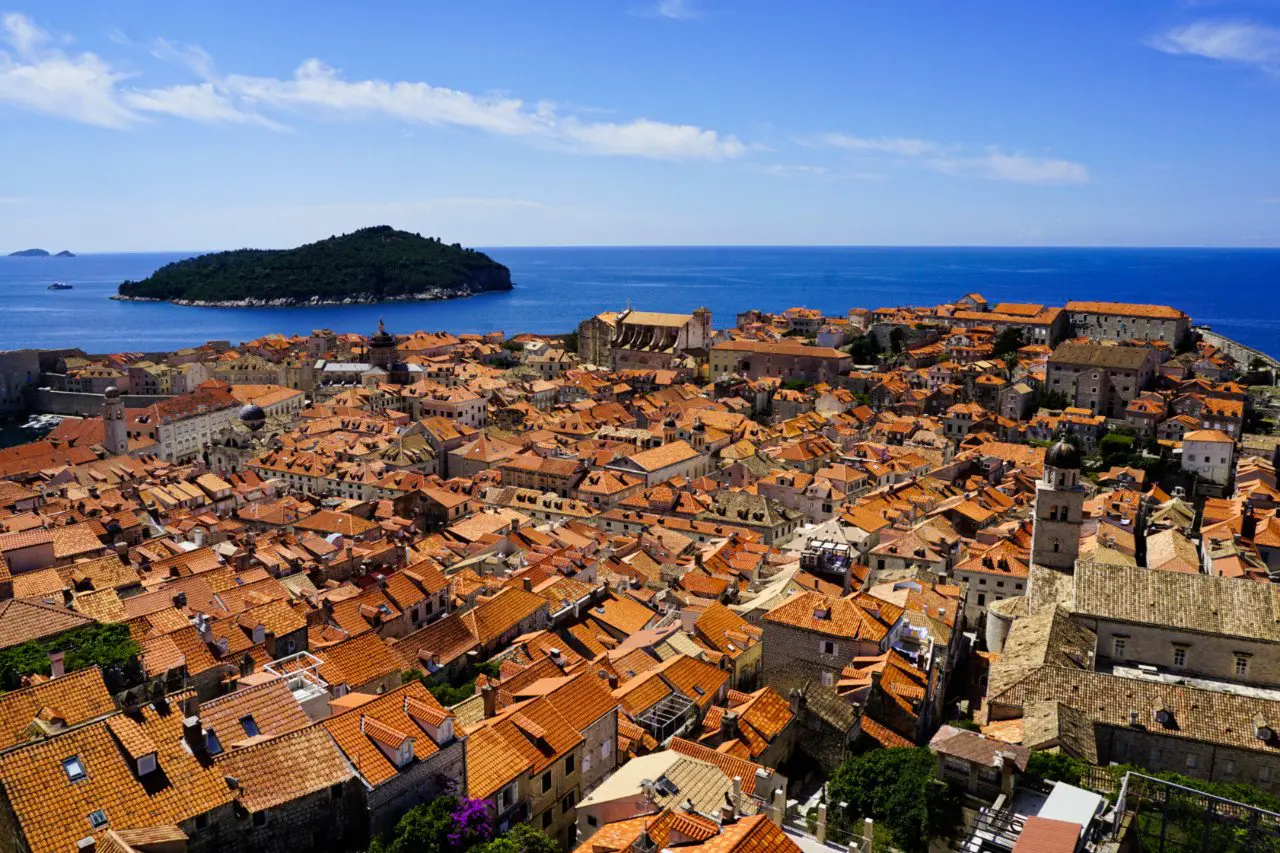

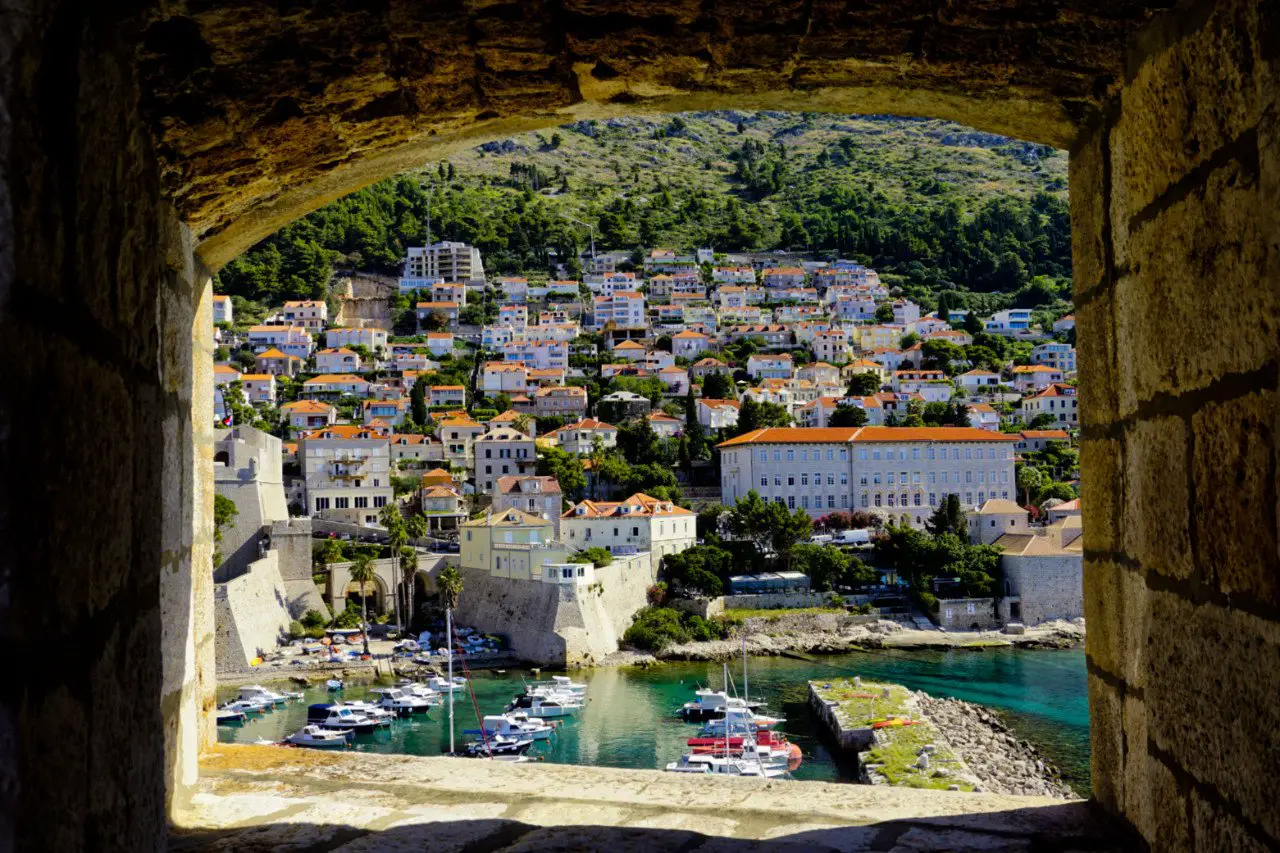
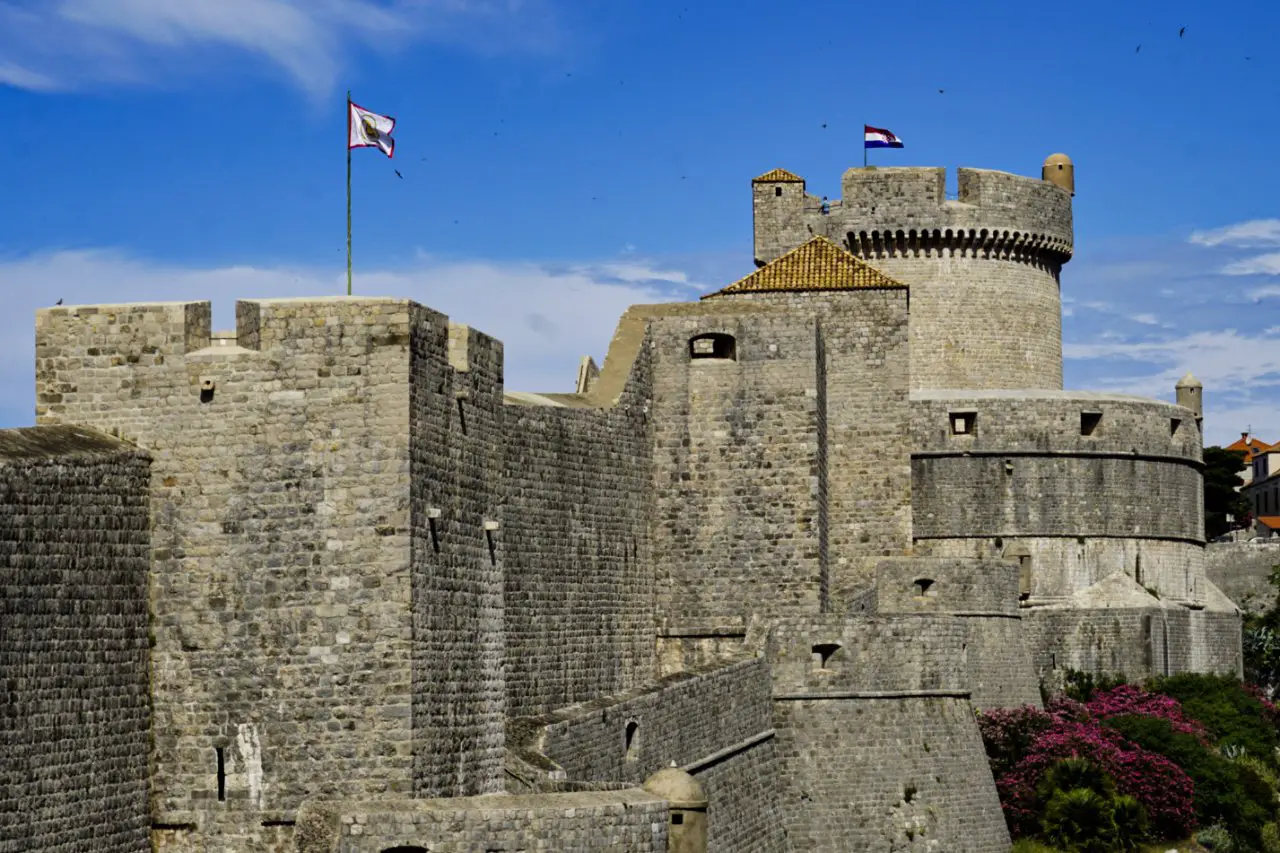
Fort Lovrjenac (St. Lawrence)
This lonely fort adjacent to the City Walls was built atop of a 37-meter (121 ft) slope to guard the city from the west.
From Pile Gate follow the signs to the stairs that’ll take you to its entry door. The entrance ticket to the walls will also give you access to this fort. The views of the Old Town are worth the effort to go up!
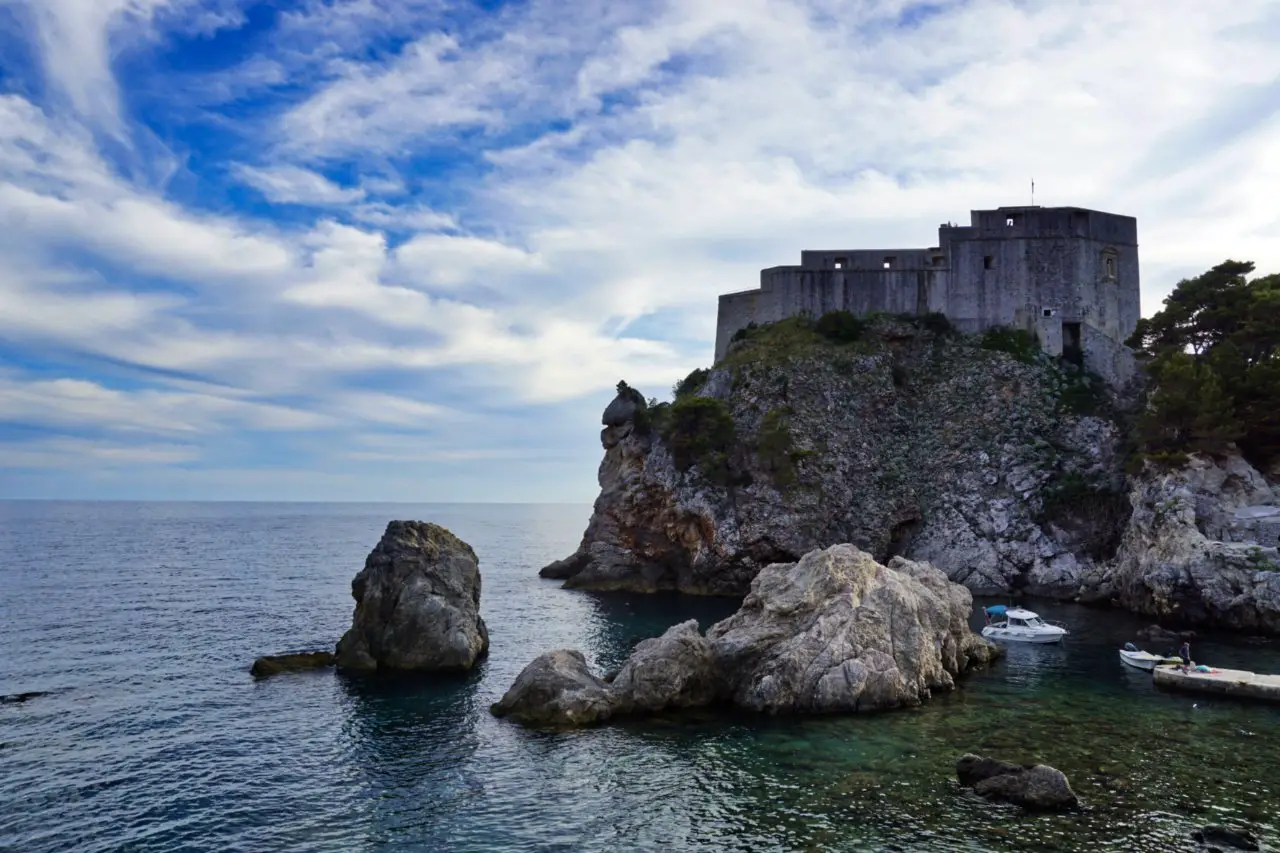
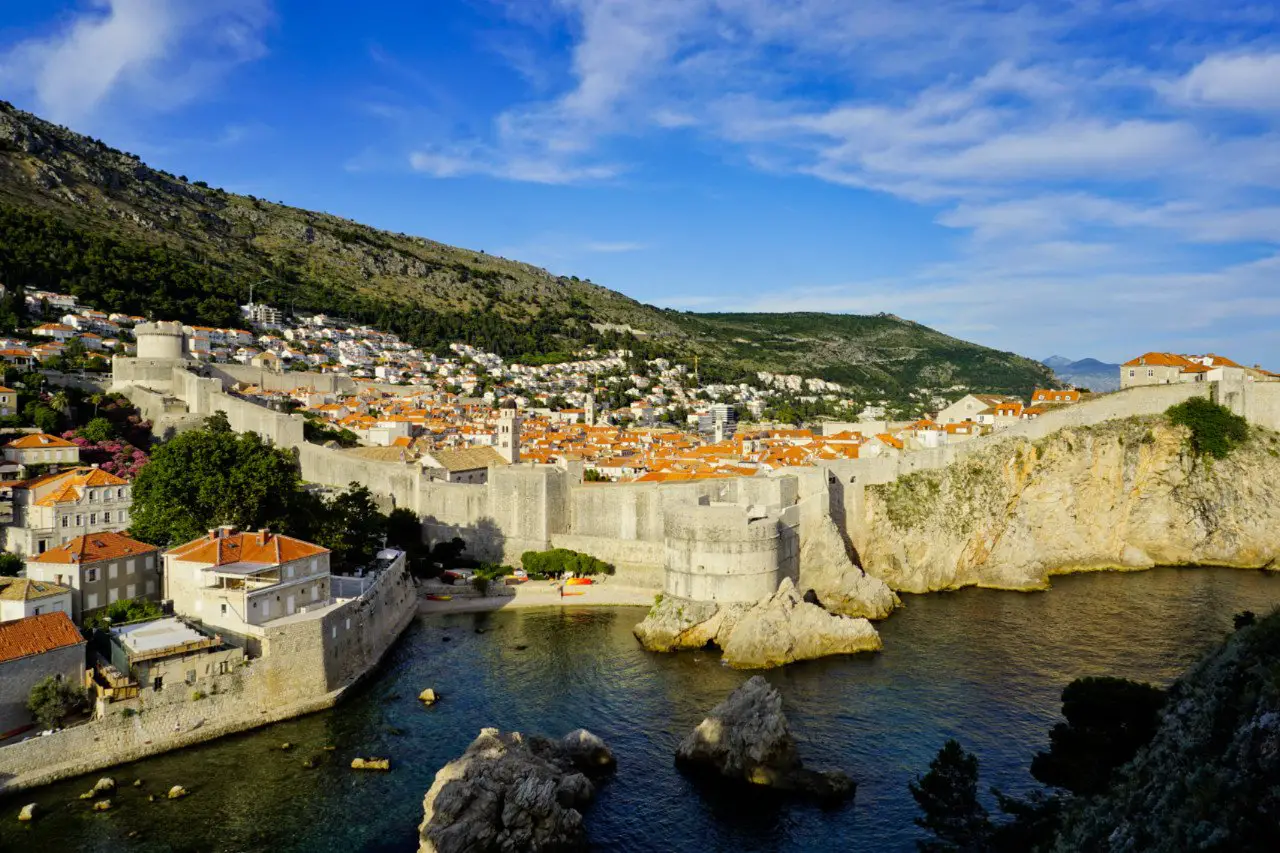
Dubrovnik Old Town
Between defensive towers and churches, a unique city developed. Packed buildings taking every inch from the seaside to the mountains, stairs replace streets in many parts of this inspiring town. Everything is a labyrinth worth getting lost into. In every corner there’s another perfect shot.
The main sights mostly dot the core passageway of the Old Town: Placa (better known as Stradun). From the Pile Gate you’ll find the Large Onofrio Fountain, part of the 15th century water supply system, in front of the Franciscan Monastery and St. Savour Church. The Monastery features a beautiful cloister with a small garden, and the third oldest functioning pharmacy in Europe.
At the other end of Stardun is Luža square, with Orlando column in the center and both the City Bell Tower and the Little Onofrio fountain in front of it. On one side is the St. Blaise Church, built in the 18th century and dedicated to the patron of the city. In its altar a statue of the saint holds a scale model of pre-earthquake Dubrovnik. On the other side is the Sponza Palace, built at the beginning of the 16th century, with a mix of styles. A Renaissance portico rests on six Corinthian columns. Today only the ground floor is open to the public, where you can see the magnificent cloister, and pay respects to those who perished during the Homeland War in the Memorial Room of the Defenders of Dubrovnik.
To the north is the Dominican Monastery, a 14th century Gothic-Renaissance fortress-like complex. To the east is the old harbor. And to the west is the Gothic-Renaissance, 15th century Rector’s Palace, followed by the Cathedral of the Assumption, a Baroque 18th century replacement of the destroyed 7th century basilica.
From there, stop by the Gundulićeva poljiana Market to shop like the locals do. And visit the Baroque St. Ignatius Church, sitting atop of a broad set of stairs, which you’ll easily recognize if you’re a Game of Thrones fan –shame, shame, shame!
If you want to fully immerse in the world of King’s Landing, I’d recommend a Game of Thrones tour, where a knowledgeable guide will take you though all the filming locations in town, and will share anecdotes about the production of the show.
Also, don’t miss the War photo Limited exhibit, a gallery featuring the outstanding work of photojournalist Wade Goddard during the Yugoslav War.
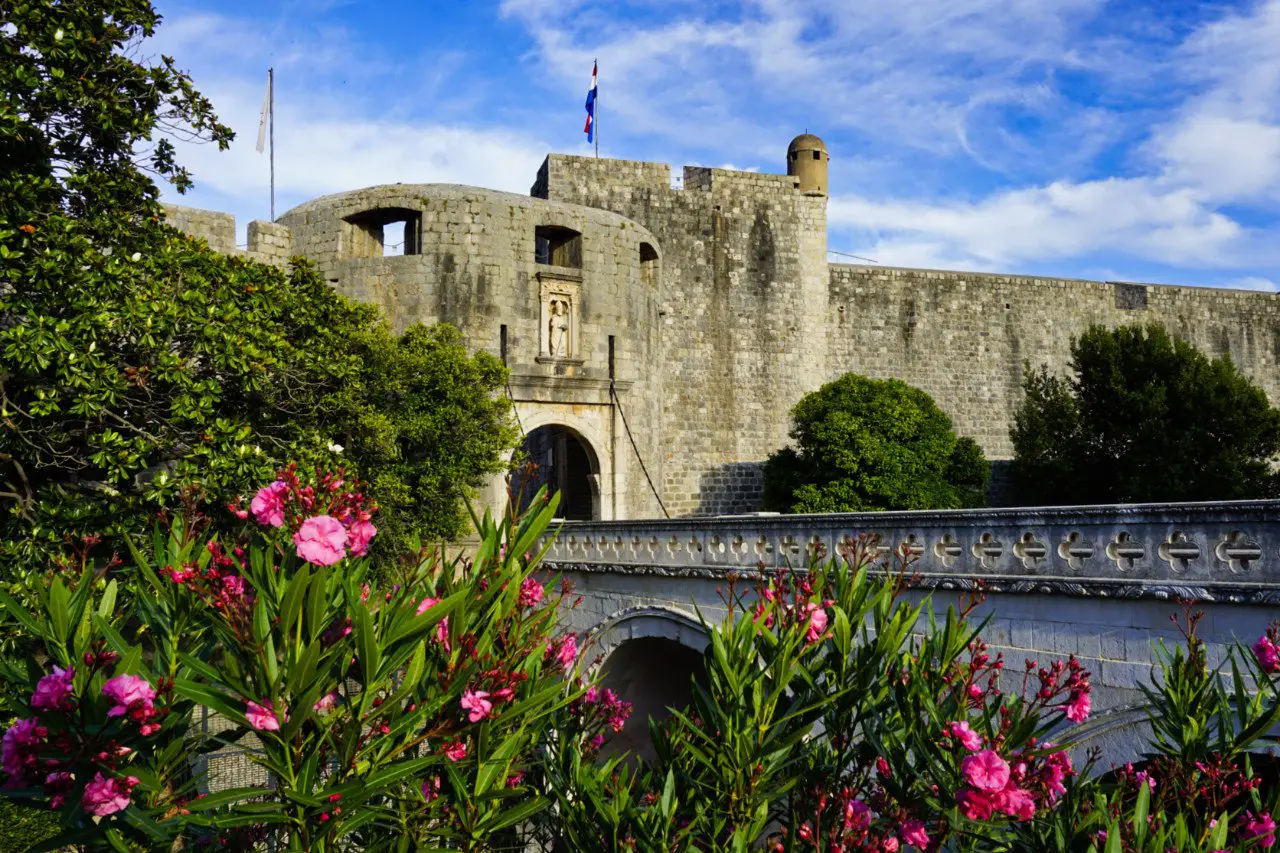
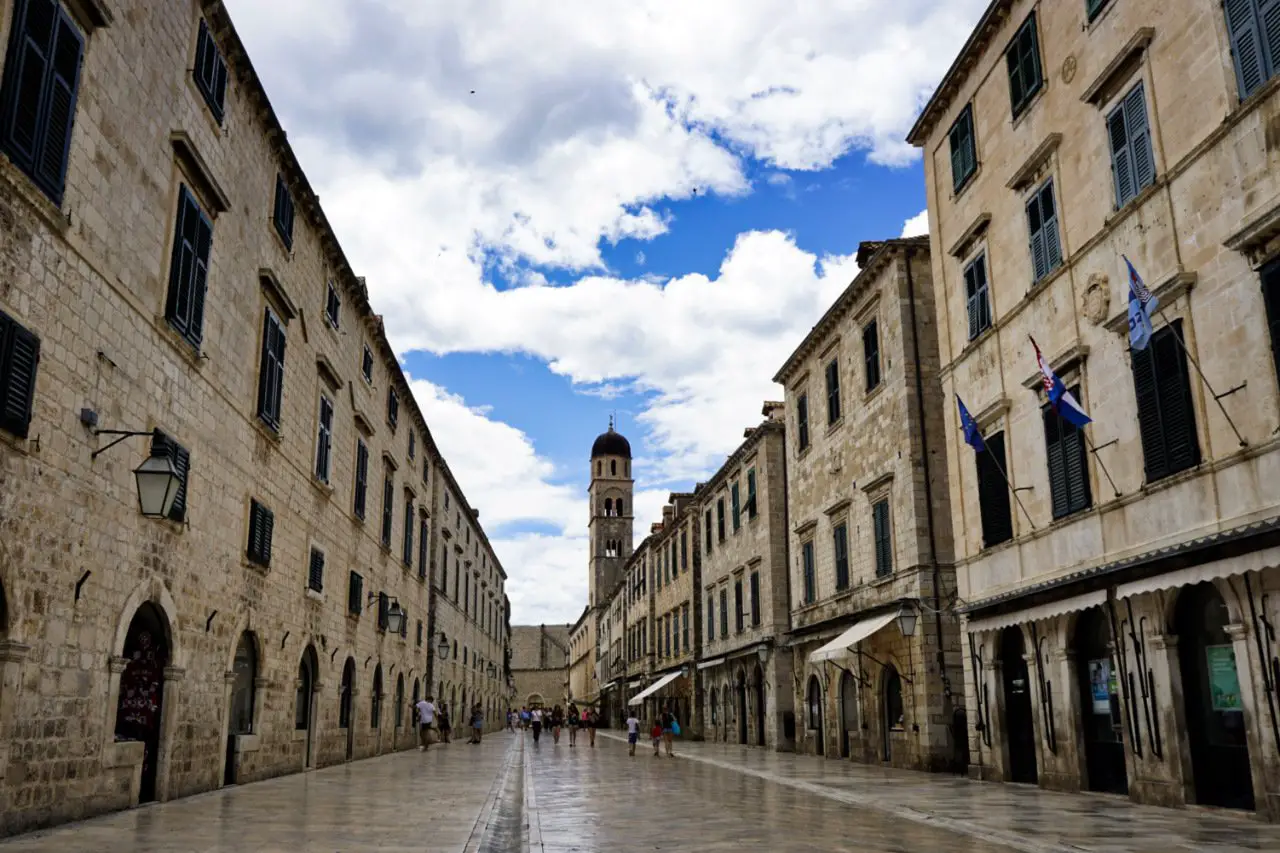
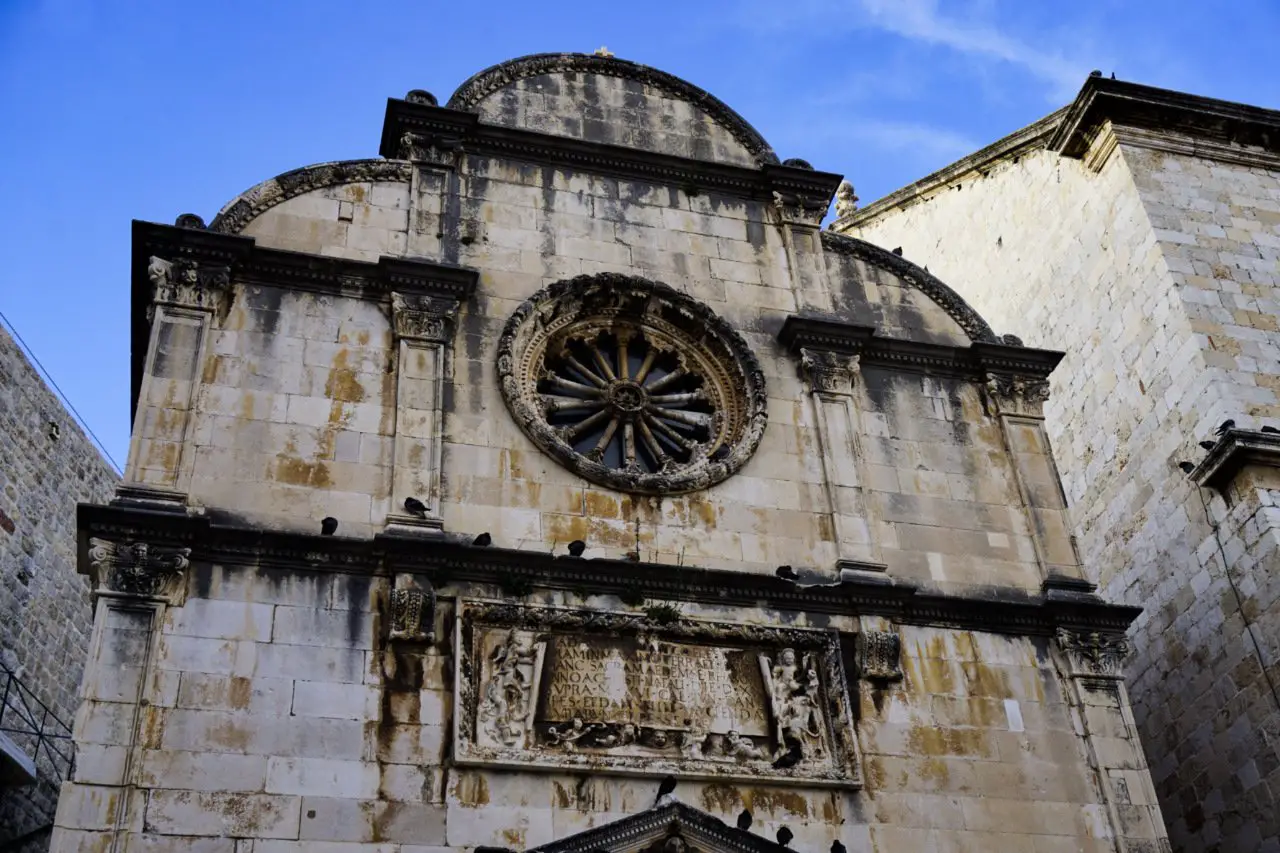


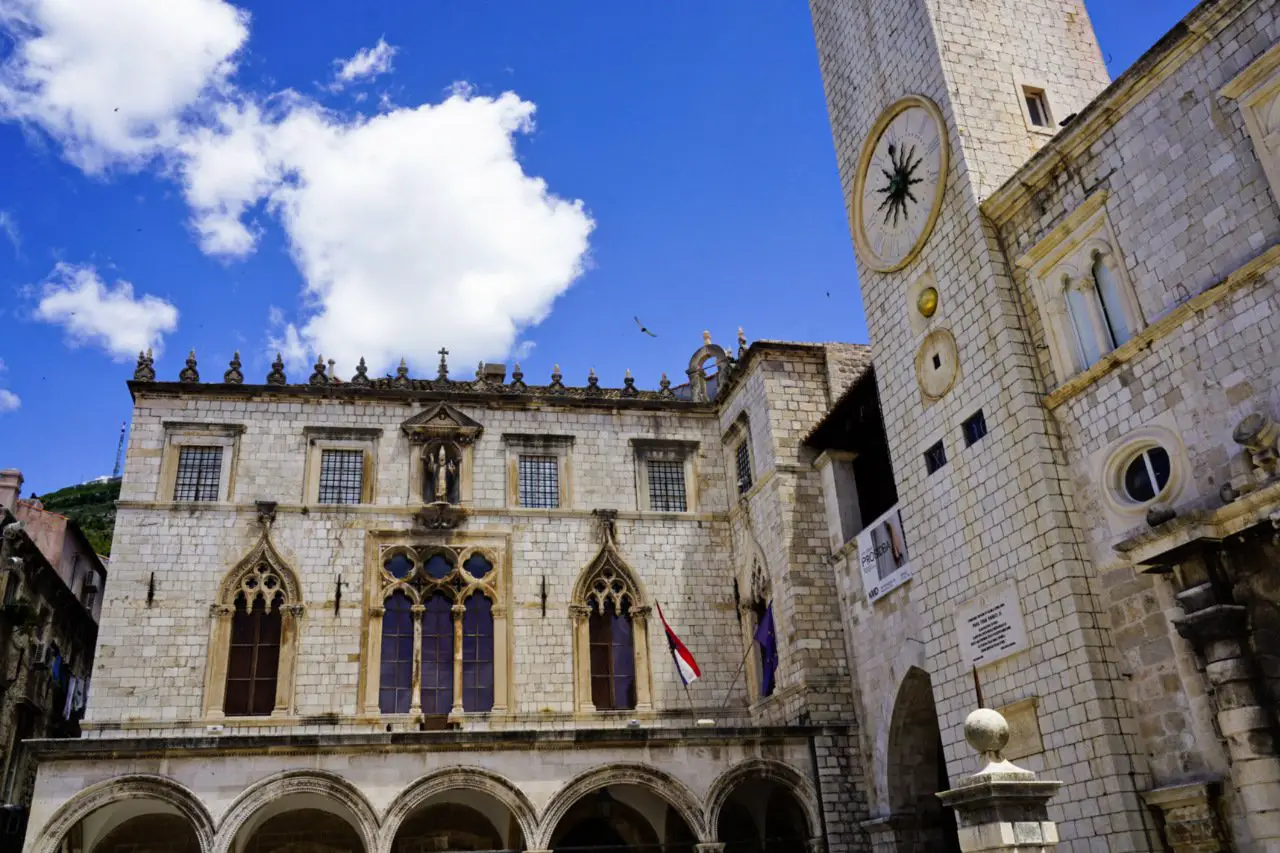
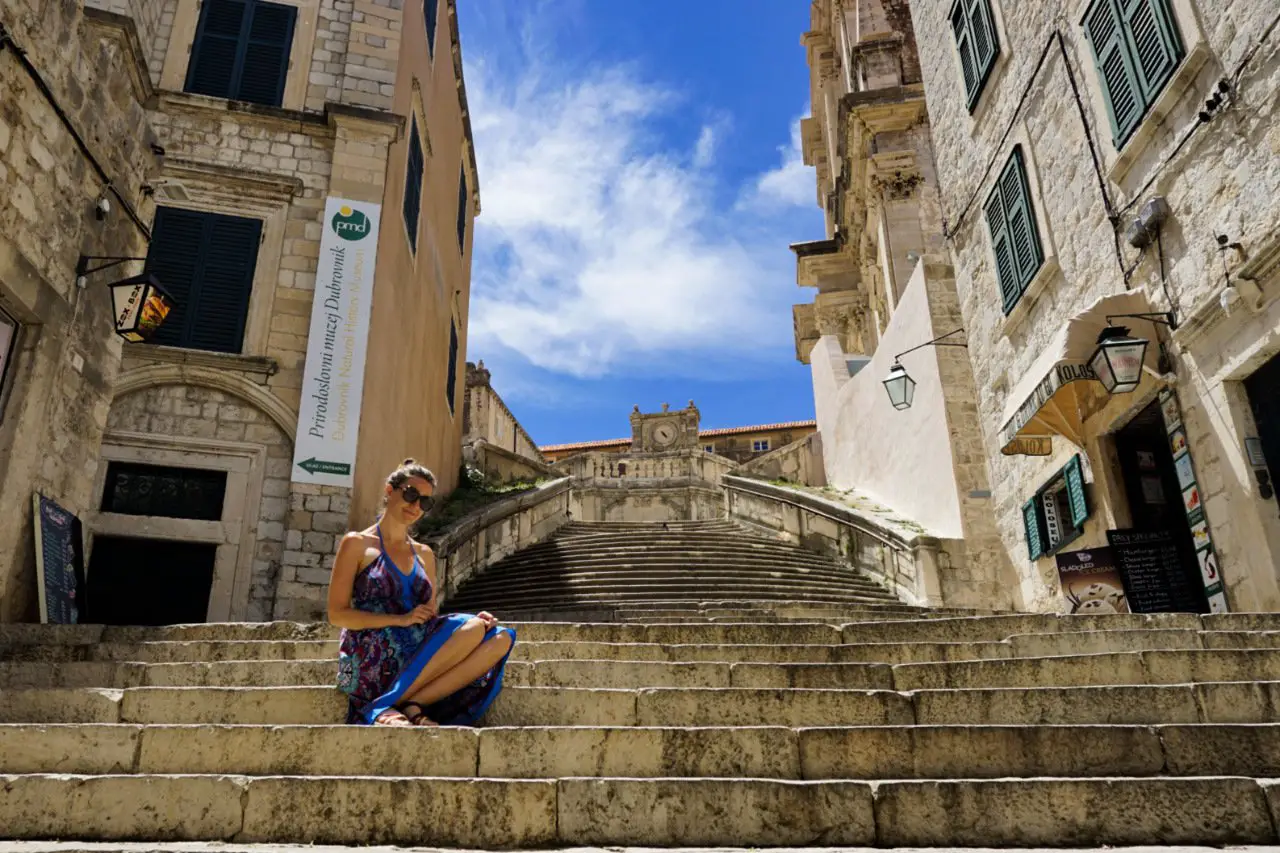
Mt Srđ
This 412-meter (1352 ft) hill overlooks the city, giving its visitors a spectacular panorama of the Old Town and its surrounding walls, plus Lokrum and the Elafiti islands. There’s a hiking path to reach the top, or you can simply take the cable car (check the official site for prices and working hours).
My recommendation is to go up in the evening, to see the city with daylight, and wait for sunset for awe-inspiring views. There’s a restaurant/bar on top, so you can enjoy a drink while absorbing the vistas.
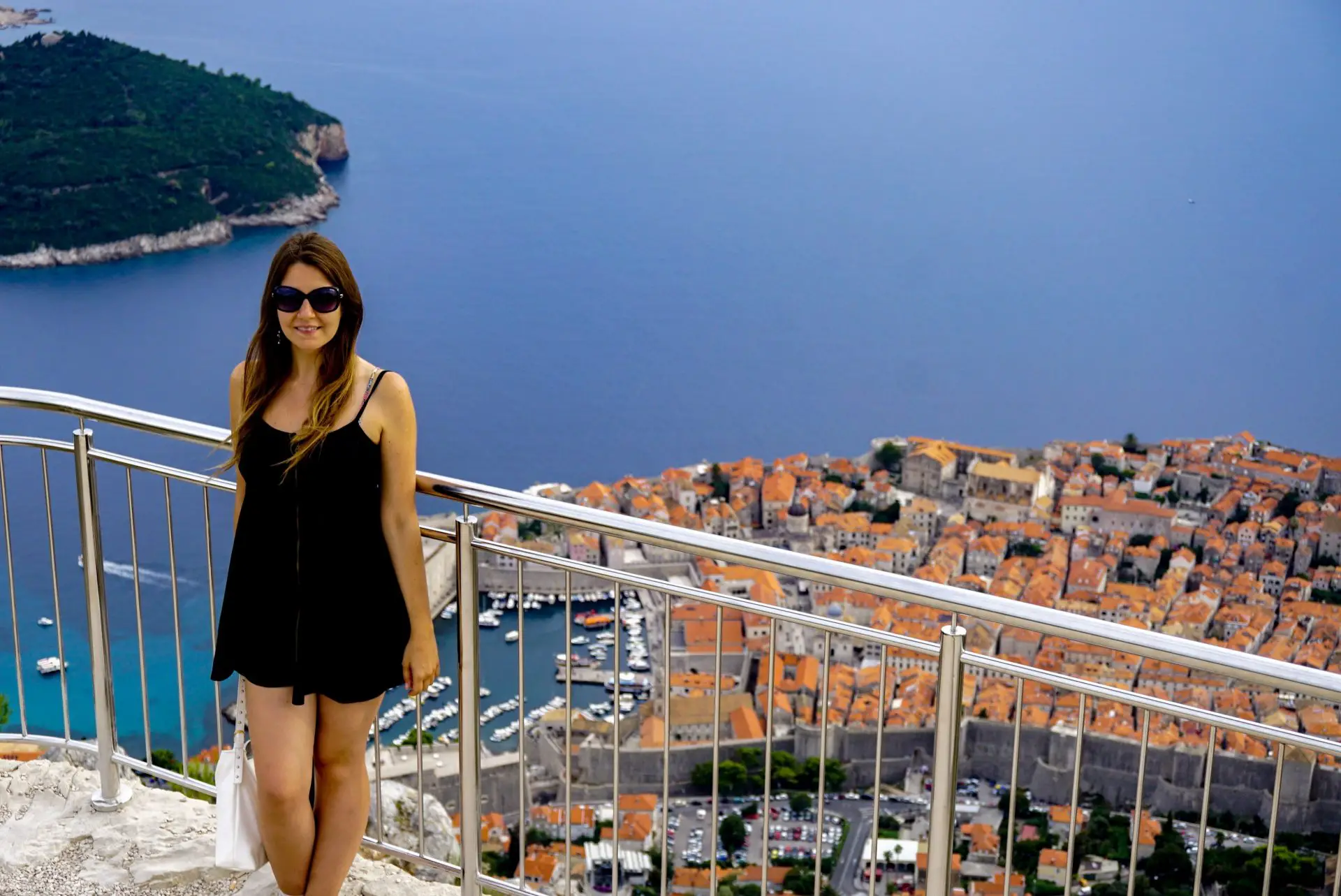
Beaches in Dubrovnik
You’ll find dozens and dozens of places to swim and sunbathe. From tiny coves to established beaches, you can choose a secluded spot if you want peace, or a popular location with beach bars and music.
The most known is Banje beach, just outside the Old Town, a few-minute walk from Ploče Gate. There you’ll find a small beach with lovely views of the city, plus drinks, food and water sports –kayak rental, wakeboard, flyboard, and the like. Towards the east, there’s Sveti Jakov beach, with the same vibe, but crowded mostly by locals.
To the east of Pile Gate there’s the rocky Danče beach, at the feet of Gradac park.
In Lapad, the bay where most of the resorts in town are located, the most popular beaches are Bellevue and Uvala Lapad, while in the northern part of the peninsula, Babin Kuk, the best one is Copacabana, where you can find water chutes, kayaks, jet skis, banana boats, and plenty more aquatic entertainment.
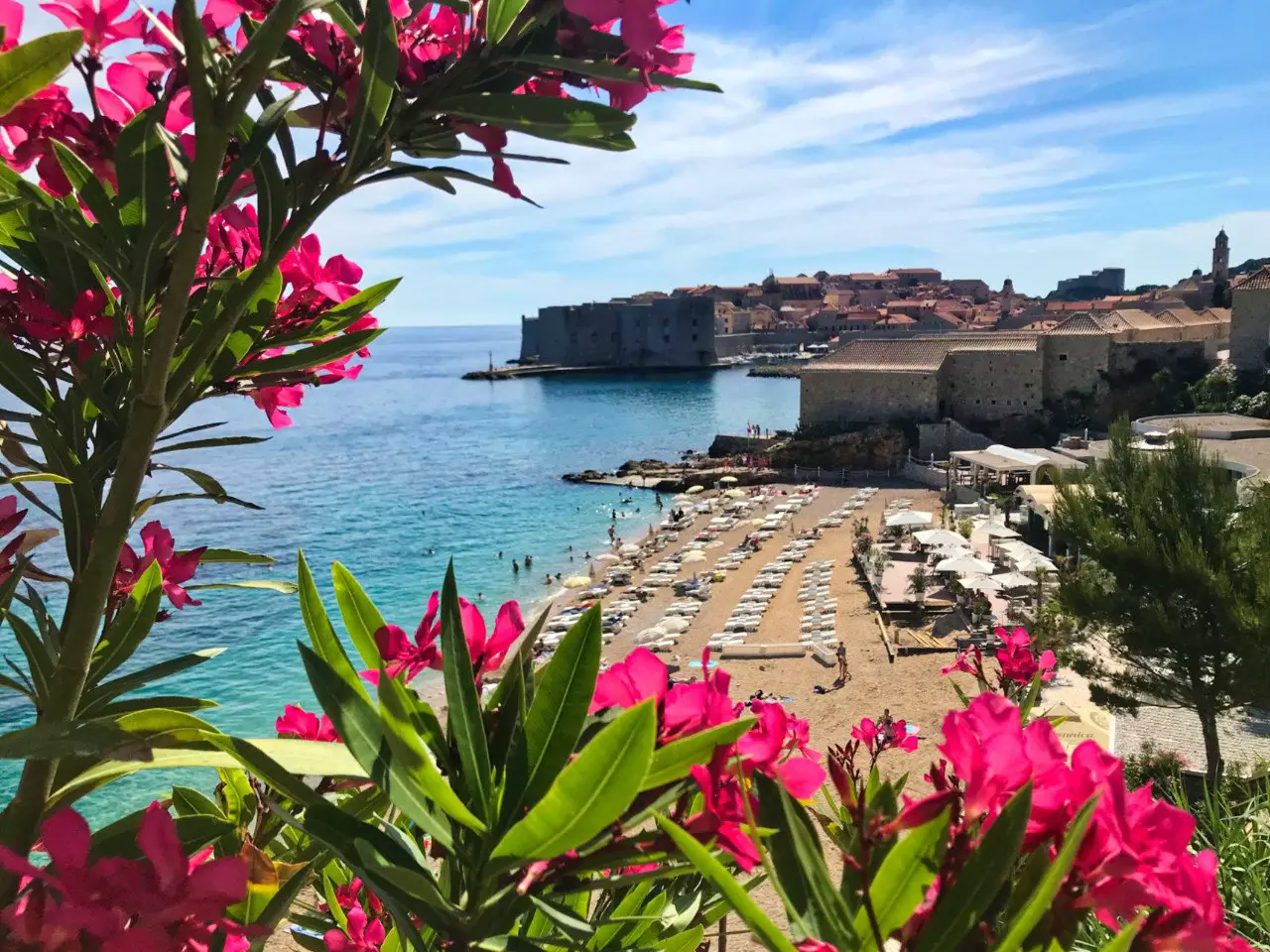
Kayak to sunset and other adventures
A beautiful way to see the day fading into the night is by taking a sunset sea kayaking tour. You’ll spend a few hours paddling beneath the City Walls and around Lokrum island, and you’ll get the opportunity to swim and snorkel in the Betina cave.
For the coolest aerial views, you can fly above the Adriatic Sea, a forest canopy, and steep cliffs in this 900-meter zipline in a Superman position, or watch the sunset from above followed by local wine tasting with this sunset and wine zipline experience.
Cliff bars
Bard Mala Buža and Buža Bar are a hole-in-the-wall, literally. Drinks are expensive, but the views and the possibility to jump to the sea at any point during your stay makes them a cool spot. They get crazy busy during sunset, so stop by at any other time.
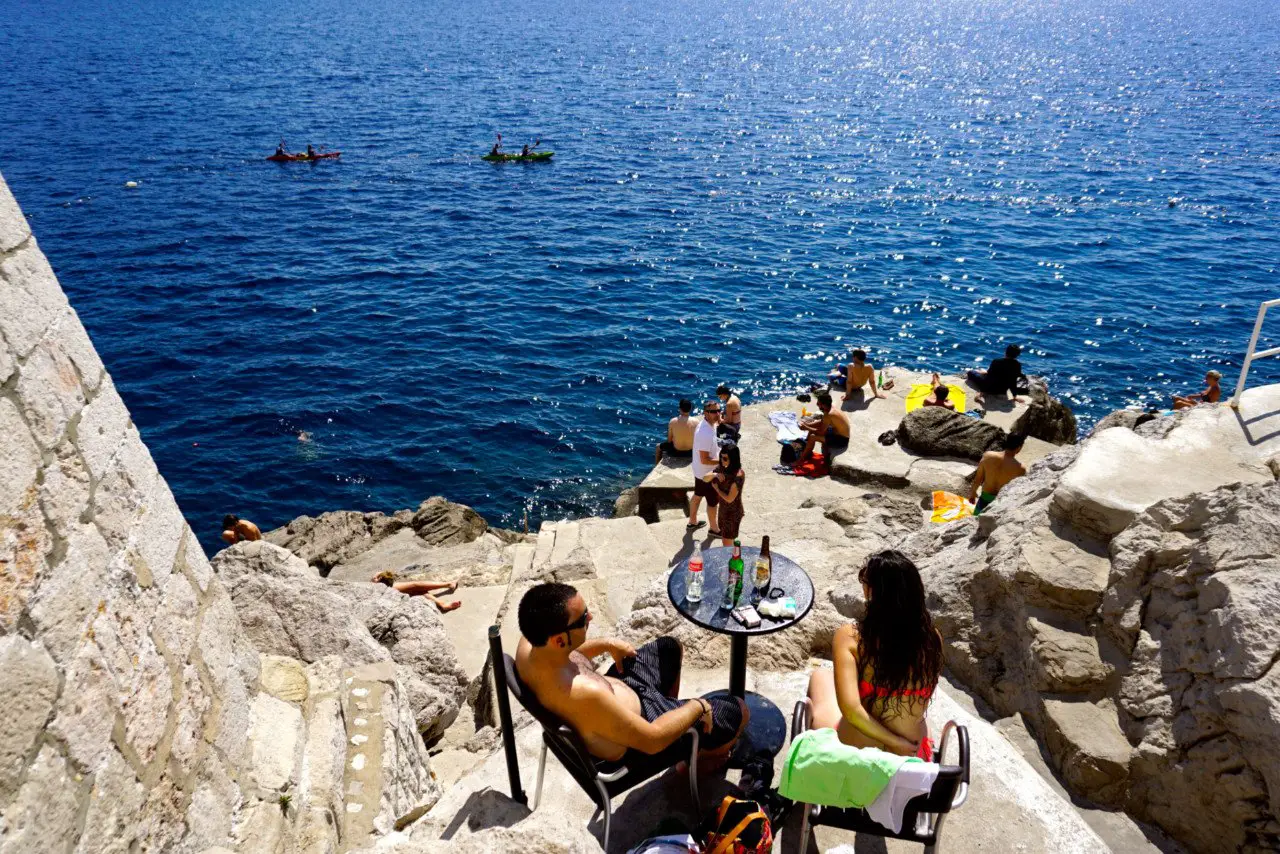
Lokum island
A quick 10-minute ferry ride will transport you from architecture heaven to nature’s paradise. This beautiful lush small island is the perfect escape from the city.
It’s a nature reserve where you’ll find rocky beaches, forests and exotic flora and fauna. The island is also home to the remains of a Benedict Monastery and garden –which nowadays holds a Game of Thrones exhibition, where you can sit in the Iron Throne. There’s also Fort Royal in the highest point of the island, at 97 meters (318 ft), with incredible views of Dubrovnik’s Old Town. And you can find the “Dead Sea”, a small lake linked with the open sea, an ideal spot to swim and find some shade by the water.
Ferries leave hourly from Dubrovnik’s old harbor (every half an hour during the peak of summer), from April to November. Check their official site for current times and prices.
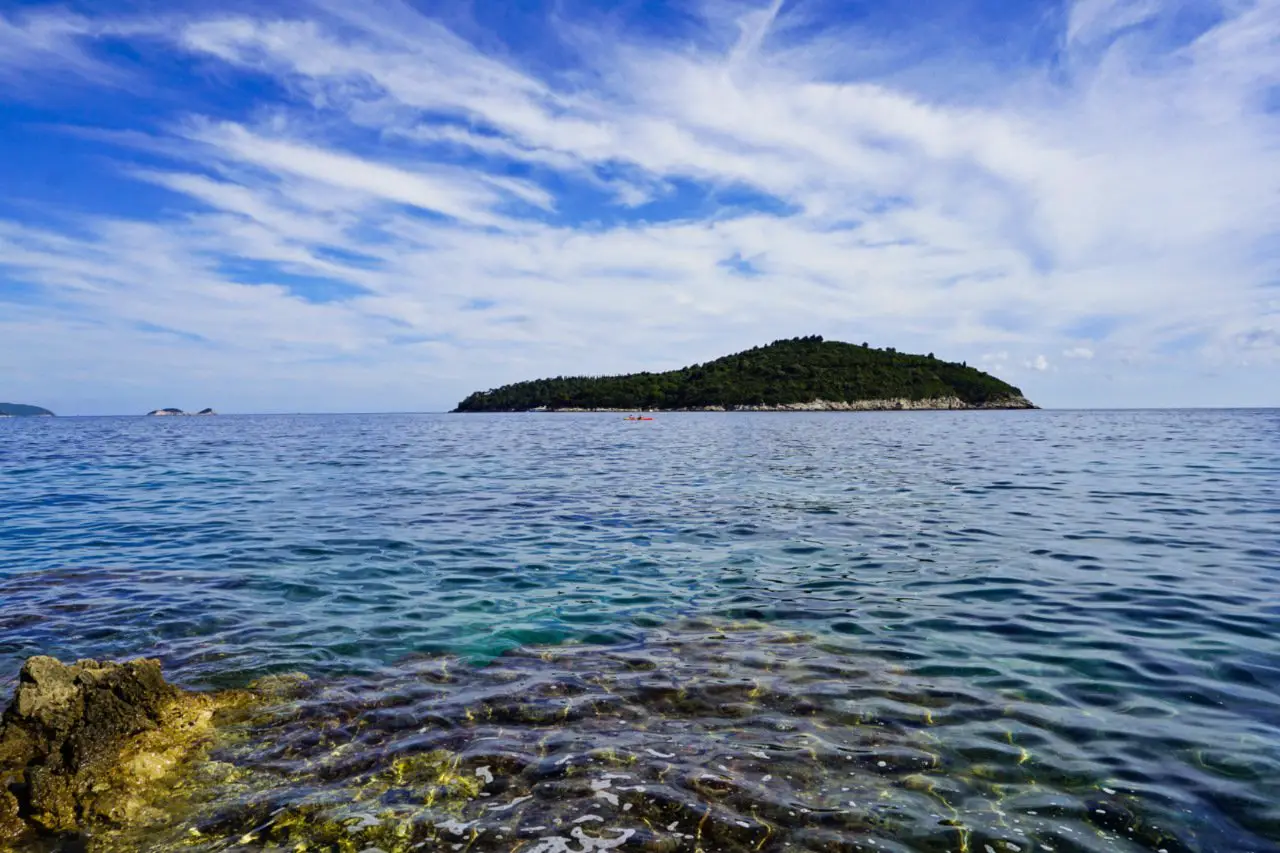
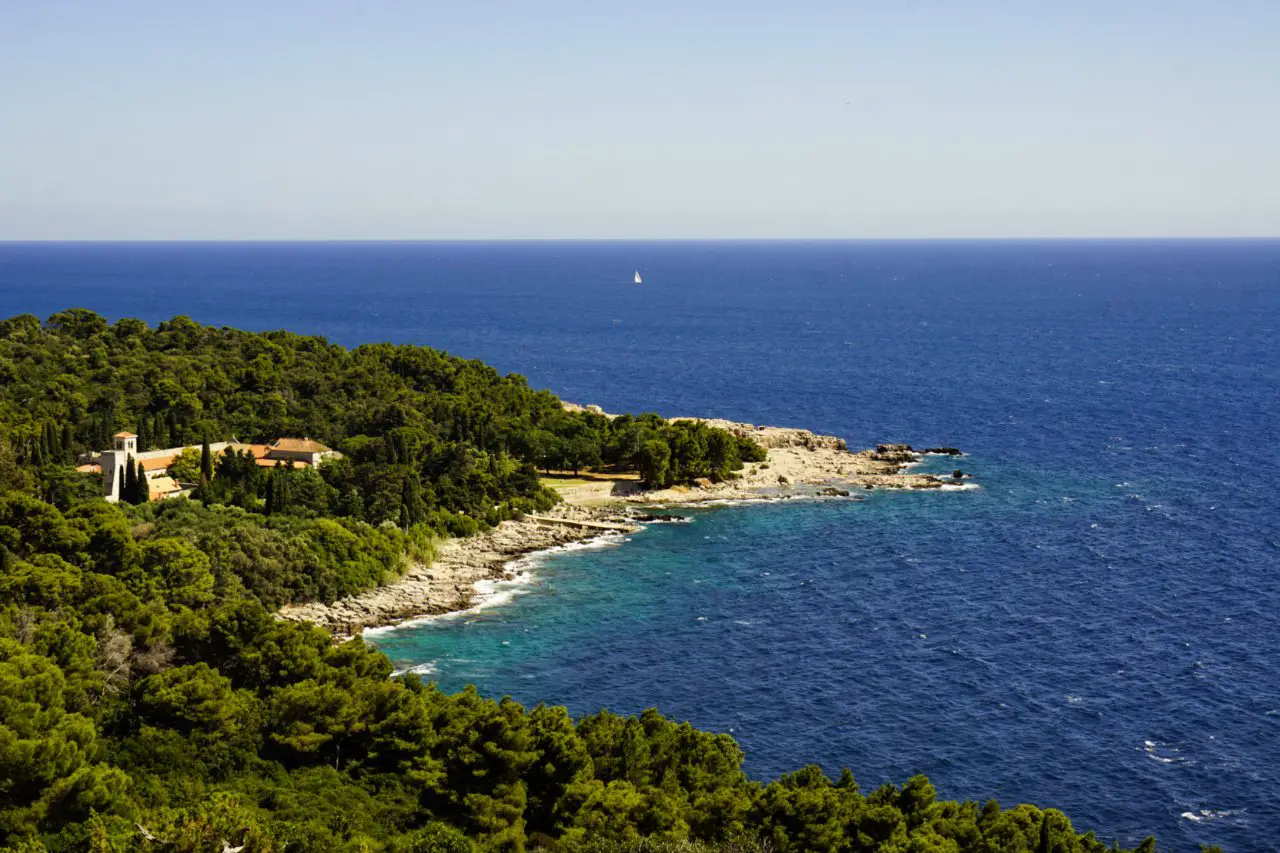
Dubrovnik Summer Festival
Even though I strongly advise to avoid visiting Dubrovnik during the peak of summer, I can’t not mention the Dubrovnik Summer Festival, an iconic event in the city, which has been celebrated since the 1950s.
It is held every year between the 10th of July and the 25th of August, offering a broad programme of music, drama, exhibitions, opera and ballet, in several locations around the city.
Tickets can be purchased in the official site, however, some of the events have free entrance.
Day trip from Dubrovnik & where to go next
Day trips
The best options for day trips are to Cavtat, an old Greek turned Roman city, founded on the 6th century BC; Trsteno Arboretum, a beautiful Renaissance garden (and the setting of the Red Keep palace gardens in King’s Landing); and the Elafiti islands, an archipelago with three inhabited islands which are a breath of fresh air, pure peace from hectic Dubrovnik. You can do a full-day 3-island tour from the old harbor, or take a ferry from the ferry port and visit one or two in a day, independently. Another beautiful trip is a half-day of swimming and snorkeling in the Blue Cave.
All the destinations in the next section can also be done as a day trip, but I truly feel they deserve more time, so I’d recommend staying for one night at the very least. If you don’t have the time to stay longer, then I’d suggest taking a tour, because visiting these places independently can be time consuming. Here are some recommendations:
Where to go next?
Croatia is fairly small and quite easy to navigate, so most people jump from Dubrovnik straight to Split, Istria or Zagreb. But the surrounding area has tons to explore.
The Pelješac peninsula is the heart of Croatia’s wine country, offering also amazing beaches and cute little villages to completely disconnect for a few days.
In the same peninsula is Ston, an important historic town, famous for its salt production, and its defensive walls, known as the “European Wall of China”.
The islands in the Dubrovnik-Neretva county are also a must-visit. Korčula is a mini Dubrovnik, a beautifully preserved small walled city that claims to be the birthplace of Marco Polo (and even though it wasn’t, it’s charming). Mljet –my personal favorite island– is a lush paradise, with a National Park with two beautiful lakes in one side of the island, and world-class sandy beaches on the other.
Dubrovnik is also a good starting point to explore neighboring countries. Kotor in Montenegro and Mostar in Bosnia and Herzegovina are just about two hours away.


Sustainable tourism in Dubrovnik
How to visit sustainably and help fighting overtourism in Dubrovnik
Dubrovnik is paying the price of its own success. Overtourism is slowly destroying the city’s charm, and also the experience of those who visit it. But there’re plenty of steps you can take to be a sustainable traveler, and improve your travel experience to enjoy your visit to Dubrovnik to the fullest.
Don’t take a cruise
Cruises are a great way to visit islands and fjords, but they tend to be harmful when it comes to cities. Dubrovnik is home to 28.000 people –with only about 1.500 living inside the City Walls–, and during high season it used to welcome several ships a day. Since 2019 there’s a 2-cruise limit per day, which translates into 5.000 tourists, most of them hanging around within the walls. Add the ferries, private yachts, buses and cars, and the result is overtourism. There’s no way you’ll enjoy your visit with this many people around.
Instead, stay in the city for longer, at least a few days. You’ll get to properly see it without rushing through the walls, and you’ll contribute to the local economy by paying for accommodation and meals that otherwise you’d get on the cruise.
Visit off season
I keep saying this over and over every single time I talk about sustainability, but I can’t stress it enough: avoid peak season!
Shoulder season in the Adriatic coast is amazing. It still feels like summer, with the sea warm enough to comfortably jump in from May to October, but sans the crowds!
Winter is also spectacular. I’ve written a whole guide about winter in Croatia, because there’s plenty to do all over the country, but for Dubrovnik is extra especial, since they celebrate their patron saint, St. Blaise, on the 3rd of February –a tradition that has been going on for over a thousand years!
Don’t visit as a day trip
It’s really common to squeeze Dubrovnik in when in Montenegro or Bosnia and Herzegovina. These neighbor countries’ most visited places –Kotor and Mostar– are close to the Croatian border, so it’s easy to be tempted to check one more country off. Well, it’s not worth it as a day trip… You’ll be running, you’ll just get a glimpse of the city, and you’ll end up spending more time in motorways and border control than in the place you wanted to visit.
Same goes the other way around. If you want to visit Montenegro or Bosnia –and trust me, you do– you should leave at least a few days for them.
Connections between the three countries are easy. There are regular routes from and to Dubrovnik bus station.
RELATED POST: Best of Sarajevo: where the East meets the West
Eat and drink locally
Dubrovnik is right next to the Neretva Valley, a mirage of fruit groves, crops and canals. This oasis in an otherwise jagged seaside, provides the city with fresh and seasonal ingredients, so make sure you try them. A lovely eatery in town is Nishta, a vegan restaurant that highlights local produce with so much flavor that even carnivores won’t notice the lack of meat.
The nearby Pelješac peninsula and Korčula island provide beautiful local wines. If you don’t have time to visit them, try D’vino or Malvasija wine bars.
Avoid single-use plastic
Remember we talked about the innovative water supply system built in the 14th century? Medieval engineering works wonderfully, even today! The two Onofrio fountains (in each end of Stradun) offer potable water to everyone in the city. Just make sure you have a reusable water bottle and fill it up while you sightsee.
The general rule in the touristic sights in Croatia is that water is drinkable unless specifically stated otherwise.
Get out of Stradun
This 300-meter (985 ft) limestone-paved pedestrian street is the heart of the city, connecting the two main gates into the Old Town. Sure you’ll walk it, but remember to also leave it. There’s a lot more within the walls –just follow any alleyways upstairs to discover more of the town.
Also remember than there’s more than the Old Town. Go to the beaches in Lapad, hike (or take the cable car) to Mt. Sđr, and visit Lokrum island. You’ll get beautiful views of the city, but you’ll help with un-crowd it.
RELATED POSTS:
- The Ultimate Guide to Sustainable Travel
- Sustainable Travel Photography
- Eco-friendly hiking: sustainable tips and packing guide
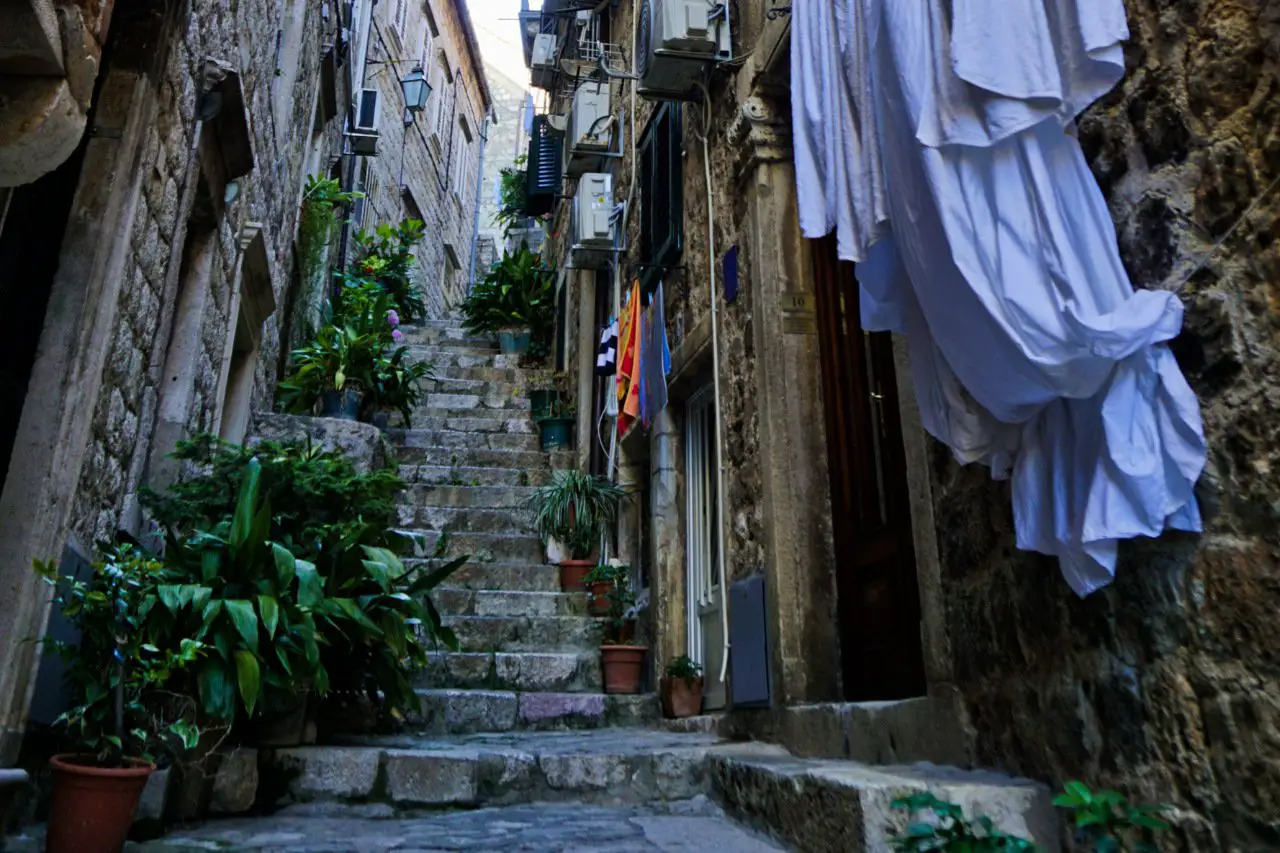
Practical information
I wrote a guide with my best Croatia travel tips, all I’ve learnt after living in the country for years, so check that out for general info about Croatia.
How to get to Dubrovnik
Airport
Dubrovnik airport (DBV) is about 19 km (12 mi) from the Old Town.
There’s a shuttle bus that will drop you off at the Pile Gate, the ferry port or the bus station. Its operation is tied to each flight’s arrival or departure, leaving the airport 30 minutes after each flight arrival. It works 7 days a week, all year around. To reach the airport, the shuttle bus starts from the bus station (and stops at the bus stop near the cable car entrance), departing 90 minutes prior to each flight. The price is 10/14 euros for a one-way/return ticket.
A taxi will cost you 40-50 euros, while an Uber should be around 28-35.
Buses
The Dubrovnik bus station is about 3 km (1.9 mi) from the Old Town. The domestic routes include Ston, Ploče, Makarska, Omiš, Split, Zadar, Rijeka and Zagreb. The international routes will take you to Kotor, Budva and Podgorica in Montenegro, and to Mostar or Sarajevo in Bosnia and Herzegovina.
To reach the city, you can get a public bus –buses 1a, 1b, 3 and 8 will leave you at Pile Gate, while bus 7 will drop you off in Lapad (from Pile Gate buses 4, 5, 6 and 9 also go to Lapad). The ticket can be purchased from the driver for 2 euros.
Ferries
The ferry terminal is in Gruž, about 3 km (1.9 mi) from the Old Town. It serves the Elafiti islands, Mljet and Lastovo. During summer it also connects Korčula, Hvar, Brač, Makarska and Split.
To reach the city, follow the same instructions for public buses than from the bus station (the ferry port and bus station are right next to each other).
Where to stay in Dubrovnik
Keep in mind that this is, by far, the most expensive city in the country (probably even in the whole Balkans), so book ahead to keep your options open.
Also consider staying around the city –there are plenty of alternatives to accommodation within the walls. Lapad and Babin Kuk are great for beaches, and nearby Cavtat, Mlini or Trsteno are ideal for a more peaceful (and cheaper) stay.
I usually crash at my friends’, so I’m limited with recommendations on where to stay. But I asked my fellow travel bloggers for their best suggestions, and this is what I got:
- Sharon from Dive Into Philippines recommends Boutique Hotel Stari Grad because of its high quality accommodation with a great rooftop restaurant right in the Old Town, only minutes from everything.
- Bradley from Dream Big, Travel Far recommends Apartments Anamaria. Located just outside of the busy city, you get to spend all evening watching the ships come and go to the city via the Babin Kuk Peninsula –it’s very romantic!
- Angela from Where Angie Wanders recommend Guest House La Bohème, themed self-catering apartments and rooms with an outdoor swimming pool, situated in the Old Town by the city walls, with beautiful views of the sea.
- Stella Jane from Around the World in 24 Hours recommends Villa Klaic because the rooms are affordable yet luxurious, the breakfast is delicious, and the hotel offers complimentary drinks on a balcony with amazing views of Dubrovnik.
- Becki from Meet Me In Departures recommends Villa Stanović in Cavtat. The place is on top of the hill, so the views are beautiful. It has spectacular rooms with balconies which look out over the sea. What’s more, it’s very affordable, perfect for a solo traveler looking for a place to relax, and only a 20-minute bus ride along the coast from the Old City.
If you’re in a tighter budget, then Hostel World will be a better alternative.
→ I’d say you’re more than ready to visit Dubrovnik! But if you still have any doubts, ask me in the comments!
READ MORE ABOUT CROATIA
Liked it? Want to read it later? Pin it!
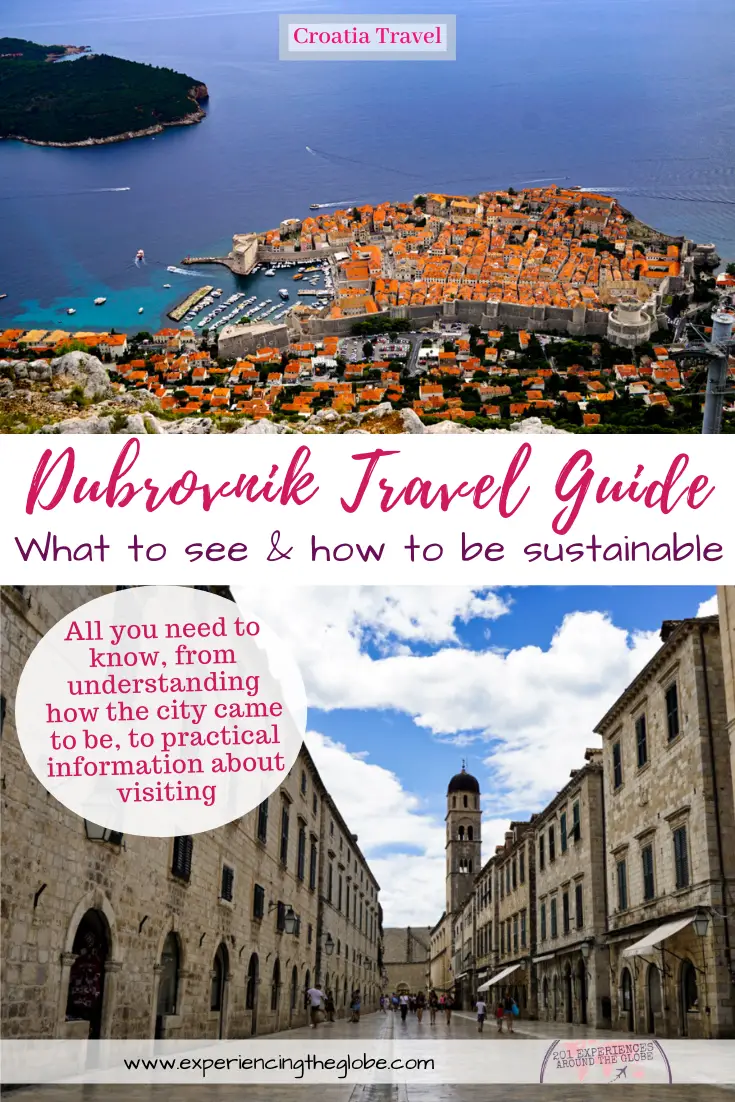
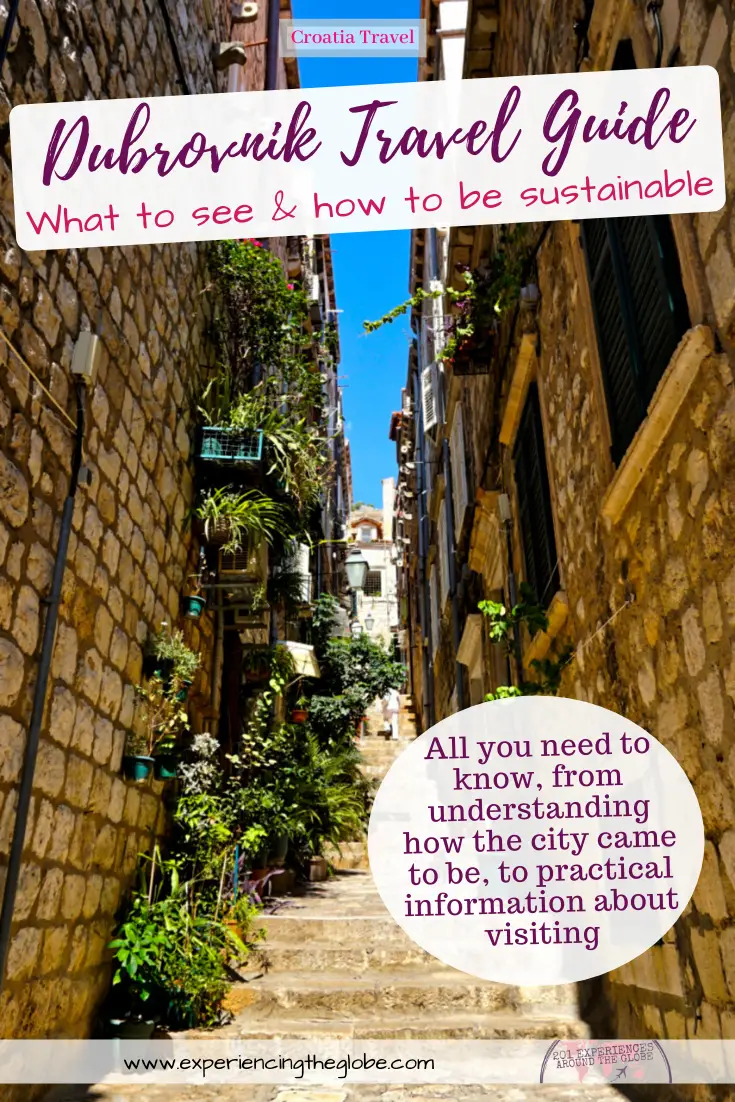
Did you like what you read? A lovely way to show your appreciation is by buying me a coffee 🙂
Your support will ensure I keep bringing you stories and insights from around the world! Thanks so much!




Love your photos. COVID cancelled a bike and boat trip last spring out of Zadar with 3 nights in Dubrovnik as part of the plan. Your post convinces me that at least 3 days is warranted.
Thank you, Anne! I’m sorry your trip got cancelled, but Croatia is fully open now, so maybe you’ll be able to reschedule it. Don’t hesitate to reach out if you have any questions when you do visit 🙂
I always thought of Dubrovnik as beaches and Game of Thrones. Now doing research for my upcoming trip (fingers crossed for this year!) I’m so happy to see there’s a lot more. My 2 allocated days just became 4 or 5, at least. Thanks so much for putting together such a great Dubrovnik guide!
That’s amazing to hear, Frankie! You’ll love Dubrovnik, especially this year that should be less crowded. Let me know if you need any other tips, and make sure you take a look at my other posts about Croatia 🙂
What a wonderful review of Dubrovnik! I’ve never been to Croatia but it’s definitely on our bucket list and we will have to see Dubrovnik while we’re there. your part about visiting in a sustainable and respectful manner is so important. Loved your photos and details, thanks for sharing!
Thank you, Arielle! So glad you enjoyed the post! Dubrovnik is the most known destination in Croatia (and it deserves the fame), but there’s a lot more! Make sure you check my other guides about the country to get inspiration on your itinerary, and don’t hesitate to reach out to me with any questions 🙂
An incredibly detailed guide and I LOVE that you address the over-tourism. I am in constant search for more authentic experiences, and how can I better help the local communities through the places that I visit, other than support big chains, and feel overwhelmed with crowds. This is great!
Thanks so much, Paula! Authentic and sustainable experiences should be what every traveler looks for, to fully immerse on the place we’re visiting, so talking about overtourism and sustainability is an important step to start changing people’s way of approaching a destination 🙂
Wow this is probably the best article I’ve read about Dubrovnik! I always wanted to visit Croatia but because of being over touristy, I’ve always avoided it, and now you’re just making me want to go in Autumn or Winter! Thank you for sharing all of those useful tips and information!
Awww! Thanks so much for your sweet words! You’ll love it here in autumn or winter -there’s a completely different vibe than in summertime. Hope to see you around soon!
It makes me so happy to see responsible city guides! I still haven’t been to Dubrovnik but it’s definitely a place I would like to go. I’ll save this for future reference. Thanks for sharing!
It’s so important to focus on sustainability, especially in places that suffer from overtourism! Hope you get to visit soon and use all these tips 🙂
Great post! I have wanted to visit Dubrovnik for so long. It looks so beautiful there. Thanks for sharing a sustainable guide to visit!
I really think Dubrovnik is one of the most beautiful cities in the world, and everyone should see it, but it has to be done sustainably to protect it. I’m so glad you’re interested in being a responsible traveler! Let me know how the trip goes!
Fantastic post, thanks for sharing! I’m glad they’ve limited cruises to 2 per day, it gets so out of control sometimes. I loved Dubrovnik but I was also lucky and visited on a quieter day, and I worry about the impact of overtourism in small places like that.
The city is trying, but it’s hard to balance sustainability with an economy that depends on tourism. That’s why it’s important that we travelers don’t contribute to overtourism, and know how to visit sustainably 🙂
I really liked this guide! It is very informative with lots of advice. Thank you for sharing! I would love to visit Dubrovnik, hopefully soon!
Thanks for your kind words! Hope you get to visit Croatia soon -it’s a really spectacular country!
I really want to visit Croatia, and now especially Dubrovnik. Happy I saw your guide now I know not to squeeze it into a day, also I really want to visit those cliff bars, they look epic!
There’s so much to see and do in Croatia! Hopefully you’ll have time to explore when you come. Make sure you see all my other guides with tips about the country. And reach out if you have any questions 🙂
I am a Croatian so it is always good to see when someone is writing about my homeland. Thank you! Much useful information!
Awww! That’s lovely yo hear! I’ve been living in Croatia for years now, and I love to showcase my adoptive country ❤️
Dubrovnik is so beautiful but also such a victim of mass tourism! So I think it’s really nice that you put up this sustainable guide, super helpful!
I’m so glad you enjoyed the read! Thanks for your nice words 🙂